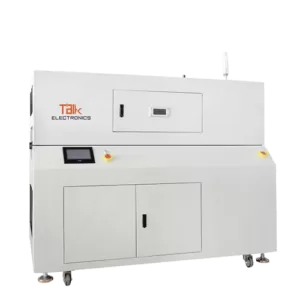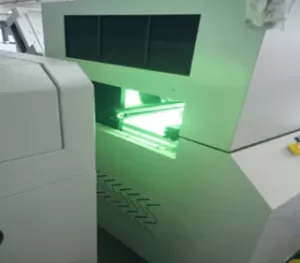UV Curing Ovens
UV curing ovens are specialized equipment used in various industries to cure or polymerize materials using ultraviolet (UV) light. The UV light triggers a chemical reaction that quickly hardens or cures materials such as adhesives, coatings, inks, and resins.
Key Features and Components of UV Curing Ovens
UV curing ovens consist of the following key features and components:
UV Light Source
The primary component of the oven is the UV light source, which emits high-intensity ultraviolet light. This UV light triggers the curing process of UV-sensitive materials.
Conveyor System
In many UV curing ovens, a conveyor system transports the items through the oven. This ensures that the materials receive even exposure to the UV light for consistent curing.
Control Unit
The control unit manages the operation of the UV curing oven. It controls parameters such as conveyor speed, UV light intensity, exposure time, and temperature (if applicable).
Cooling System
Some UV curing processes generate heat as a byproduct. A cooling system, such as fans or air circulation, may be included to prevent overheating of the cured materials.
Reflectors/Reflective Surfaces
Reflectors or reflective surfaces inside the oven are strategically positioned to maximize the distribution of UV light onto the items being cured, ensuring uniform curing.
Safety Features
UV light can be harmful to human skin and eyes. UV curing ovens often have safety features like interlock systems and protective barriers to prevent exposure to UV light.
Advantages of UV Curing Ovens
Some of the key advantages of UV curing ovens include:
Speed
UV curing is rapid compared to traditional curing methods. The curing process takes seconds or minutes, leading to increased production efficiency.
Quality
UV curing produces materials with enhanced properties, such as improved adhesion, hardness, and durability.
Environmentally Friendly
UV curing eliminates the need for solvent-based curing methods, reducing volatile organic compound (VOC) emissions.
Energy Efficiency
UV curing requires less energy compared to heat-based curing methods.
Applications of UV Curing Ovens
UV curing ovens are used across many industries:
Printing
UV-cured inks and coatings are used in commercial and industrial printing to achieve vibrant colors and rapid drying.
Electronics
UV-curable adhesives, coatings, and encapsulants are used in electronic assembly for bonding and protection.
Coatings and Finishes
UV-cured coatings are applied to products ranging from wood finishes to automotive paints.
Medical Devices
UV curing is used in the manufacturing of medical devices and dental products.
UV Curing Process
The UV curing process involves:
Photoinitiators
These absorb UV light and generate free radicals to initiate polymerization.
Free Radicals
The free radicals propagate the curing reaction and link monomers together into polymer chains.
Polymerization
The monomers rapidly join into polymer networks, solidifying the material.
UV Lamp Types
Common UV lamp types include:
Mercury Arc Lamps
Offer high intensity broad-spectrum UV output for rapid curing times.
Metal Halide Lamps
Generate less heat while providing a broad UV spectrum.
Excimer Lamps
Emit high density but narrow-band UV which allows curing with minimal heating.
Implementing UV Curing
To implement an effective UV curing process:
UV Curing Materials
Choose formulations specifically designed for UV cure and polymerization.
Lamp Configuration
Position lamps and use reflectors to ensure uniform light distribution.
Process Validation
Test on a small scale first to validate quality and cure level.
Safety Procedures
Establish proper precautions for working with UV light and ovens.
UV Curing vs Thermal Curing
Some differences between UV curing and thermal curing:
UV curing is significantly faster while thermal curing takes much longer.
UV curing requires UV-sensitive formulations while thermal curing works with most materials.
UV curing generates less heat and allows curing heat-sensitive materials.
The energy consumption of UV curing is lower compared to thermal curing methods.
Limitations of UV Curing Ovens
Some limitations include:
UV curing works best for materials that are sensitive to UV light and have appropriate photoinitiators.
Additionally, the curing depth may be limited to the surface layers of thicker materials.
Future Outlook for UV Curing Technology
Emerging trends in UV curing include:
Increased adoption across more industry verticals
UV LED technology providing more tunable and energy efficient curing
More automated monitoring of process parameters
Innovation in photoinitiator chemistry
Hybrid UV and thermal curing techniques



